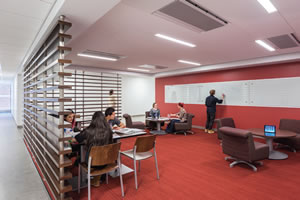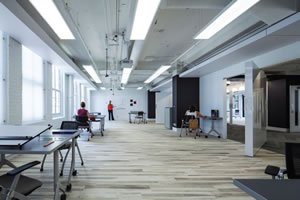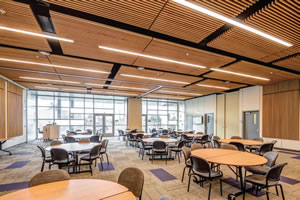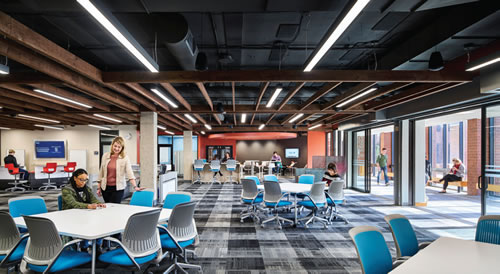The Handwriting Is on the Wall
- By Michael Fickes
- 06/01/17

PHOTO © JAMES STEINKAMP PHOTOGRAPHY
Remember when you were a kid and you liked to write on the walls? Chances are, it didn’t go well for you. Parents and teachers always objected to the practice.
But things are changing. Today, some forward-thinking college and university instructors (as well as K–12 teachers, for that matter) want students to write on the walls. Well, at least they can write on walls that have been designed and installed for writing, erasing and writing again.
These teachers also want students to push classroom walls around. Today’s advanced walls are moveable as well as writable.
“It’s important for educators to get familiar with moveable walls and writable walls,” says Shawn Gaither, AIA, LEED-AP, architect and senior associate in the Minneapolis offices of the DLR Group. “Our higher ed clients ask me what I’ve learned about moveable and writable walls in school installations.
“In fact, our higher-ed clients are requesting writable surfaces on virtually every application. They want a classroom environment designed to help them teach.”
What has precipitated this? According to Gaither, the rising importance of collaborative learning and teaching has led educators to begin asking for moveable and writable walls with word processing capabilities. Not only can teachers and students write on these walls, they can save the work like in the same way documents are saved on a laptop computer.
These walls are metal, too, enabling students to attach work done on paper with magnets.
Why Should Your Walls Move Around?
Moveable walls enable lecture halls to divide themselves up into small rooms designed for seminar-sized numbers of students. In these classrooms, the furniture — the desks where students sit — must also move to make the most of the altered space.
A year ago, for example, the DLR Group brought advanced walls to a project at the University of Minnesota Student Center. The project redesigned the entire second floor, which houses several student cultural centers.
“The reason the university asked for a flexible environmental design is that the numbers of students using the different cultural centers varies significantly over time,” Gaither says. “For instance, when the Asian Student Union began to burst at the seams, we repositioned the walls to accommodate the larger group. At the same time, we reduced the space available to centers attracting fewer students.”

PHOTO © DON F. WONG
Gaither also notes that hardware firmly anchors the moveable walls when they are set in place. “Students, faculty and visitors cannot move the walls,” he says. “These walls are composed of four-foot-wide by eight-foot-tall panels, and the facilities crew handles the chore of attaching the panels to the floor and the ceiling. “The facilities people do that work.”
Moving Walls Require Planning
To accommodate students and teachers, rooms require high levels of daylight, good acoustics and an effective heating, ventilating and air-conditioning (HVAC) system. Getting all of this right requires research and thought. How will the room be used? How many people will typically be in the room? What wall configuration will best accommodate the room’s users?
“Daylight is important to effective learning today,” Gaither says. “Transparent panels are important to moving daylight through a space. Of course, transparency is also important from the point of view of safety. So when we create meeting spaces and classroom spaces, it is important for users to see into and out of the spaces.”
For instance, notes Gaither, if a student in the student union begins to act out, it’s important that adults in the area see that student and react.
Then there are the electrical and mechanical systems. “Think about the placement of electrical boxes. When attaching panels to the ceiling, remember the placement of the mechanical system’s components above the ceiling,” Gaither says.
How Much Does It Cost To Move Walls? Does It Really Save Money?
According to Gaither, buying and installing moveable walls carries a premium cost — but there is a payback. “The first time you move moveable walls you pay for them by eliminating the cost you have been paying to move sheetrock walls,” he says. “You don’t just save the cost of materials but you also increase productivity. Unlike sheetrock walls, moveable walls sit on top of the carpet and can be moved in a day.”

PHOTO © MARK DAVIDSON
There is a potential downside, however, continues Gaither. “If you invest in moveable walls and then don’t move them, you’ve paid more than you should have,” he says. “A new sheetrock wall may be one-third of the cost of a moveable wall.”
The point: make sure you really need and want moveable walls. If such walls are only something you might use, you might not want to buy them.
Educational Benefits for Students
Another benefit of moveable walls, notes Gaither, is that moveable walls can help prepare students for the environment of the modern workplace.
“When we discuss moveable walls with college and university clients, we talk about how young people work,” he says. “They are working to learn, now. Eventually they will work for their livelihood.
“The cubicles themselves are different today. In the past, cubicle panels were 60 inches tall, and no one could see anyone else.
“Just as education is becoming more collaborative, so is the workplace. So today, cubicles come in lower panel sizes. Students can see each other over the tops of the cubicles, making it easier to collaborate.
“There’s another advantage to today’s cubicle classroom designs. Students will find similarly designed cubicles in the world of work after they graduate. So those that choose to work in an office setting will be able to start their careers in familiar surroundings.”

PHOTO © MICHAEL ROBINSON PHOTOGRAPHY
In conclusion, Gaither notes that cubicle designs shouldn’t become uniform — all the same. “We don’t subscribe to the idea that one learning space or workspace is the same throughout,” he says. “We’ve learned from experience that different spaces call for their own unique designs.”
Writable, moveable walls are here today, and there is a lot more to come. “The future will be even more exciting,” Gaither says. “We’re beginning to see products that integrate several technologies. For example, I’m thinking that the walls will one day have pressure sensitive glass — like your smartphone.
“I’m not suggesting that these products are going to be rolling out of the factory any day now. But more and more of our clients are asking about advanced technology walls.”
And when customers ask, manufacturers try to provide. Designers and manufacturers are working on walls that will do more than move, accept writing and save documents. Today, designers are beginning to find ways to add technology to walls, and tomorrow, students may discover walls that can carry out tasks like those handled by desktop and laptop computers.
Finally, the handwriting really is on the schoolhouse walls.
This article originally appeared in the issue of .